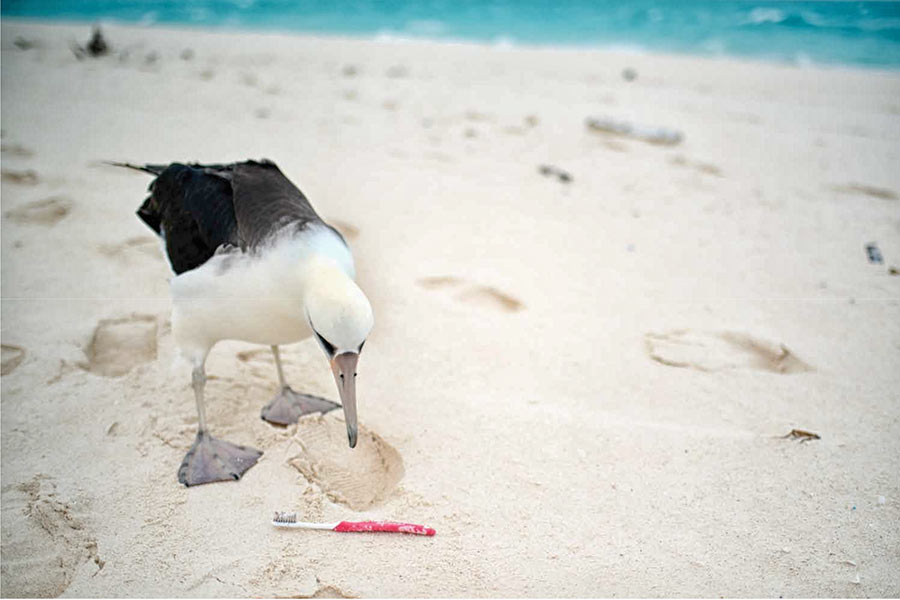In the “Rime of the Ancient Mariner”, the killing of an albatross was believed to have turned the fates against a ship in open water. “With my crossbow, I shot the Albatross,” confessed the ancient Mariner. Ruin, guilt, and pain followed. As we look across the oceans today, Samuel Taylor Coleridge’s epic poem looks prescient.
In 1966, 74 Laysan Albatross chicks became the first documented cases of sea life dying from ingesting plastics. Since that time, 250 million metric tons of plastic have been dumped into the ocean, thousands more albatross have been killed, and marine life hangs in the balance.
If you like this, subscribe here for more stories that Inspire The Future.
In the 1960s when the chicks were discovered, plastic use was one twentieth of what it is today. Since then, plastic use has doubled every eleven years, and we will soon produce more plastic in one year than all the plastic produced previously in history. The effects on marine life have been devastating. Today, 90% of the albatross chicks born in the Midway Atoll National Refuge have ingested plastic. By 2050, scientists believe there will be more plastic weight in the ocean than fish weight, and 99% of all seabirds will have ingested plastic.
Where does all this plastic come from? Most of it comes from consumers who use something once and throw it away. The majority of it is from poor countries. The U.N. estimates packaging accounts for half of the plastic waste in the world. In the
United States, for example, 500 million plastic straws are used once and thrown away each day. Worldwide, consumers use 500 billion single use plastic bags per year. In all, an estimated eight million metric tons of plastic are dumped into the ocean per year, inflicting an economic cost of $13 billion. This is on top of the 250 million metric tons already there.

The potential health, environmental, and economic costs are massive. An estimated 100,000 marine mammals and 1,000,000 seabirds die each year in the plastic killing fields. At the microscopic level, plastic is now a staple of the human diet, which gets 17% percent of its animal protein from the sea.
Fishing also contributes $1.5 trillion to the (legal) global economy, provide the livelihood to 12% of its population, and 17% of the animal protein consumed worldwide. In addition, illegal global fishing is estimated to be worth $25 billion per year.
Fortunately, unlike so many other man-made problems, continued dumping of plastic in the ocean can be solved. For one thing, the waste is actually valuable. Plastic packaging that is discarded is estimated to be worth over $100 billion a year. So, there is an economic incentive to monetize plastic trash. Doing so can help prevent plastic from being dumped in the ocean while simultaneously providing a source of income to the poor in developing countries.
There is also a tremendous potential market for any plant-based or a biodegradable plastic. For example, over 1,000,000 plastic water bottles are sold worldwide each minute, and 91% are not recycled. A bi-degradable plastic would have a huge market and likely government support. At the most recent G7 Summit in Charlevoix, Canada, five of the seven G7 members signed an Ocean’s Plastic Charter to encourage the reduction of plastic use, the development of alternative technologies, and the support of government roles in the recycling process (Japan and the U.S. did not sign).
Public awareness on the issue keeps building as well. For example, investors are starting to see heightened brand risk for companies who fail to reduce their plastic packaging. The environmental organization As You Sow recently brought together an alliance of investors representing $1 trillion in assets under management to engage companies on the necessity of reducing plastic in their packaging. The issue is not a hard sell because the environmental, economic, and moral arguments are manifest. When a garbage patch of plastic twice the size of Texas collects in the northern Pacific gyre, something is wrong. When developed countries recycle a fraction of what they can, something is wrong. When poor countries literally throw valuable trash in the ocean, something is wrong.
Given Coleridge’s poem, it is poignant that the albatross gave us our first glimpse into this problem, but it stands to reason. In the vastness of the Pacific, there is often only the albatross in sky. Some even say the albatross ferry the souls of sailors lost at sea. As it turns out, these timeless companions of the seafarer are very vulnerable to ingesting plastic. Albatross don’t dive deep; they skim the surface looking for squid and fish. Increasingly, they are ingesting all manner of plastic detritus in the process.
The albatross hung around the ancient Mariner’s neck as a reminder of what he had done. Hence the expression, “albatross around my neck.” The ancient Mariner’s lifelong penance was to tell his story so others would learn the tragic lesson:
He prayeth best, who loveth best All things both great and small; For the dear God who loveth us, He made and loveth all.
It is time to heed the ancient Mariner and stop the assault of plastic on the marine ecosystem. Anything less is tempting fate.
If you like this, subscribe here for more stories that Inspire The Future.




































